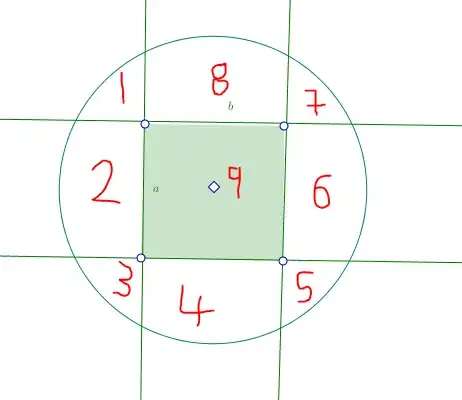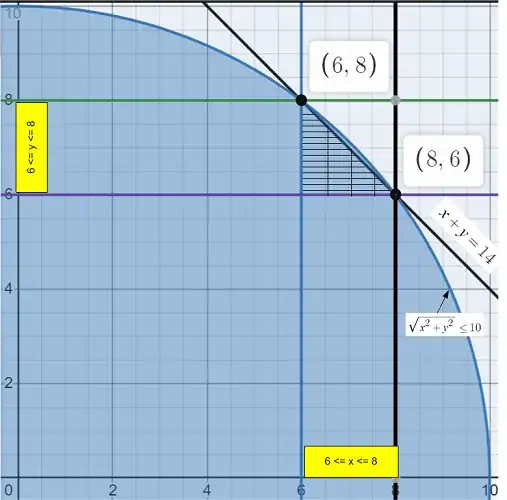lets say that both the circle and rectangle are at the same centre, my answer is best understood if visualized, in the rectangle the length " $b$ " is horizontal and the breath " $a$ " is vertical
we know that the perimeter $2(a+b)$ of the rectangle is $28$, then $a+b = 14$ and the circle has a diameter of $28$, then it's area is $\pi \cdot (20/2)^2$
obviously the area of the rectangle has to be less than the circle, since it was cut from it, then $a\cdot b < \pi \cdot 10^2$ and $b = 14-a$
interpreting the maths from my diagram, the circle $!(1,2,3,4,5,6,7,8,9)$ is cut into $9$ parts, according to my theory we would use the information to extract the dimension of the rectangle
so that area of the circle $!(1,2,3,4,5,6,7,8,9)$ equals area of the rectangle $!(9)$ plus area of the eclipse $!(1,2,3,5,6,7)$ plus area of the second eclipse $!(1,3,4,5,7,8)$ minus area of the sector $!(1)$ minus area of the sector $!(3)$ minus area of the sector $!(5)$ minus area of the sector $!(7)$
hehe, because a cicrcle has a perfect regular shape, the area of the sector $!(1)$ equals sector $!(3)$ equals sector $!(5)$ equals sector $!(7)$, this sector is the sector of some eclipse
we have to find the two radius of the eclipse $!(1,2,3,5,6,7)$ which is
$$ R_{a} = \sqrt{10^2-(\frac{b}{2})^2 } $$
$$ R_{b} = \frac{20-b}{2}$$
the radius of the second eclipse $!(1,3,4,5,7,8)$ is
$$ r_{a} = \frac{20-a}{2}$$
$$ r_{b} = \sqrt{10^2-(\frac{a}{2})^2}$$
the radius of the sector at the edge is also calculated, sector $!(1)$=$!(3)$=$!(5)$=$!(7)$
$$ ( R_{a} - \frac{ a}{2} )$$ and $$ ( r_{b} - \frac{ b}{2} )$$
area of circle $!(1,2,3,4,5,6,7,8,9)$ = area of rectangle $!(9)$ + area of eclipse $!(1,2,3,5,6,7)$ + area of eclipse $!(1,3,4,5,7,8)$ - 4 * area of sector $!(1)$
$$ \pi \cdot 10^2 = a b + \pi \cdot R_{a} \cdot R_{b} + \pi \cdot r_{a} \cdot r_{b} - 4 \cdot \frac{1}{4} \cdot \pi \cdot ( R_{a} - \frac{ a}{2}) \cdot ( r_{b} - \frac{ b}{2}) $$
$$ \pi \cdot 10^2 = a b + \frac{ \pi (20-b) \cdot \sqrt{10^2-\frac{b}{2}^2} }{2} + \frac{ \pi (20-a) \cdot \sqrt{10^2- \frac{a}{2}^2 }}{2} - 4 \cdot \frac{1}{4} \cdot \pi \cdot ( \sqrt{10^2-\frac{b}{2}^2 } - \frac{a}{2} )\cdot ( \sqrt{10^2-\frac{a}{2}^2 } - \frac{b}{2} )$$
$$ \pi \cdot 10^2 = a b + \frac{ \pi (20-b) \cdot \sqrt{10^2-\frac{b}{2}^2} }{2} + \frac{ \pi (20-a) \cdot \sqrt{10^2-\frac{a}{2}^2 }}{2} - \pi \cdot \sqrt{10^2-\frac{b}{2}^2} \cdot \sqrt{10^2-\frac{a}{2}^2 } + \pi \cdot \frac{b}{2} \cdot \sqrt{10^2-\frac{b}{2}^2} + \pi \cdot \frac{a}{2} \cdot \sqrt{10^2-\frac{a}{2}^2} - \pi \cdot \frac{a \cdot b}{4} $$
$$ \pi \cdot 10^2 - a b + \pi \cdot \frac{a b}{4} + \pi \cdot \sqrt{10^2-\frac{b}{2}^2} \cdot \sqrt{10^2-\frac{a}{2}^2 } = \frac{ \pi (20-b) \cdot \sqrt{10^2-\frac{b}{2}^2} }{2} + \frac{ \pi (20-a) \cdot \sqrt{10^2-\frac{a}{2}^2} }{2} + \pi \cdot \frac{b}{2} \cdot \sqrt{10^2-\frac{b}{2}^2} + \pi \cdot \frac{a}{2} \cdot \sqrt{10^2-\frac{a}{2}^2} $$
$$ (\pi\cdot 10^2 - a b + \pi \cdot \frac{a \cdot b}{4} + \pi \cdot \sqrt{10^2-\frac{b}{2}^2} \cdot \sqrt{10^2-\frac{a}{2}^2 } )^2 = ( \frac{ \pi (20-b) \sqrt{10^2-\frac{b}{2}^2} }{2} + \frac{ \pi (20-a) \cdot \sqrt{10^2-\frac{a}{2}^2} }{2} + \pi \cdot \frac{b}{2} \cdot \sqrt{10^2-\frac{b}{2}^2} + \pi \cdot \frac{a}{2} \cdot \sqrt{10^2-\frac{a}{2}^2} )^2 $$
$$ (\pi \cdot 10^2 - a b + \pi \cdot \frac{a b}{4} + \pi \cdot \sqrt{10^2-\frac{b}{2}^2} \cdot \sqrt{10^2- \frac{a}{2}^2 }{2} )^2 - ( \frac{ \pi (20-b) \sqrt{10^2-\frac{b}{2}^2 }}{2} + \frac{ \pi (20-a) \cdot \sqrt{10^2-\frac{a}{2}^2 }} + \pi \frac{b}{2} \cdot \sqrt{10^2-\frac{b}{2}^2} + \pi \cdot \frac{a}{2} \cdot \sqrt{10^2-\frac{a}{2}^2} )^2 = 0 $$
$$ -\frac{a \cdot \sqrt{100-\frac{a^2}{4}} \cdot b \cdot \sqrt{100-\frac{b^2}{4} } \cdot \pi^2 }{2} -\frac{a^2 b^2 \pi^2}{8} -50 a b \pi^2 +2 a\cdot \sqrt{100-\frac{a^2}{4}}\cdot b\cdot \sqrt{100-\frac{b^2}{4}}\cdot \pi +\frac{a^2 b^2 \pi}{2} + 200 a b\pi-a^2 b^2 = 0 $$
$$ \frac{ -a b \cdot ( \sqrt{400-a^2}\cdot \sqrt{400-b^2}\cdot \pi^2+a\cdot b\cdot \pi^2+400\cdot \pi^2-4\cdot \sqrt{400-a^2}\cdot \sqrt{400-b^2}\cdot \pi-4 a b\pi-1600 \pi+8a b ) }{8} = 0 $$
$$ \sqrt{400-a^2}\cdot \sqrt{400-b^2}\cdot \pi^2+ab \pi^2+400 \pi^2-4\sqrt{400-a^2}\cdot \sqrt{400-b^2}\cdot \pi-4 a b \pi-1600\pi+8 a b = 0 $$
$$ \sqrt{400-a^2}\cdot \sqrt{400-b^2} \cdot (\pi^2-4\cdot \pi)+(a b+400) \pi^2+(-4 ab-1600) \pi+8 a b = 0 $$
$$ \sqrt{400-a^2}\cdot \sqrt{400-b^2} \cdot (\pi^2-4\cdot \pi) = -(a b+400) \pi^2+(4 a b+1600)\pi -8 a b $$
$$ ( \sqrt{400-a^2}\cdot \sqrt{400-b^2} \cdot (\pi^2-4 \pi) )^2 = ( -(a b+400)\pi^2+(4 a b+1600) \pi -8 a b )^2 $$
$$ ( \sqrt{400-a^2}\cdot \sqrt{400-b^2} \cdot (\pi^2-4 \pi) )^2 - ( -(a b+400) \pi^2+(4 a b+1600) \pi -8a b )^2 = 0 $$
$$ -400b^2\pi^4-800ab\pi^4-400a^2\pi^4+3200b^2\pi^3+6400ab\pi^3+3200a^2\pi^3-16a^2b^2\pi^2-6400b^2\pi^2-19200ab\pi^2-6400a^2\pi^2+64a^2b^2\pi+25600ab\pi-64a^2b^2 = 0 $$
$$ -16( 25b^2\pi^4+50ab\pi^4+25a^2\pi^4-200b^2\pi^3-400ab\pi^3-200a^2\pi^3+a^2b^2\pi^2+400b^2\pi^2+1200ab\pi^2+400a^2\pi^2-4a^2b^2\pi-1600ab\pi+4a^2b^2 ) = 0 $$
$$ 25b^2\pi^4+50ab\pi^4+25a^2\pi^4-200b^2\pi^3-400ab\pi^3-200a^2\pi^3+a^2b^2\pi^2+400b^2\pi^2+1200ab\pi^2+400a^2\pi^2-4a^2b^2\pi-1600ab\pi+4a^2b^2 = 0 $$
$$ 25a^2\pi^4+50(14-a)a\pi^4+25(14-a)^2\pi^4-200a^2\pi^3-400(14-a)a\pi^3-200(14-a)^2\pi^3+(14-a)^2a^2\pi^2+400a^2\pi^2+1200(14-a)a\pi^2+400\pi(14-a)^2\pi^2-4(14-a)^2a^2\pi-1600(14-a)a\pi+4(14-a)^2a^2 = 0$$
$$ 4900\pi^4-39200\pi^3+a^4\pi^2-28a^3\pi^2-204a^2\pi^2+5600a\pi^2+78400\pi^2-4a^4\pi+112a^3\pi+816a^2\pi-22400\pi a\pi+4a^4-112a^3+784a^2 = 0 $$
$$1.303233786730186a^4-36.49054602844518a^3+1334.140307507042a^2-15101.89079431095a+35635.48524426483 = 0$$
$$[a=3.188302332738908,a=10.81169766726106,a=27.28084114342327i+7.000000000000011,a=7.000000000000011-27.28084114342327i]$$
therefore the dimension of the rectangle is $ 3.18 $ by $10.81$

